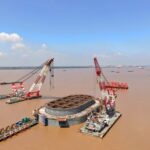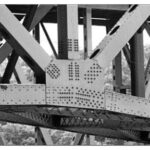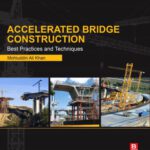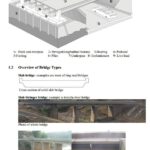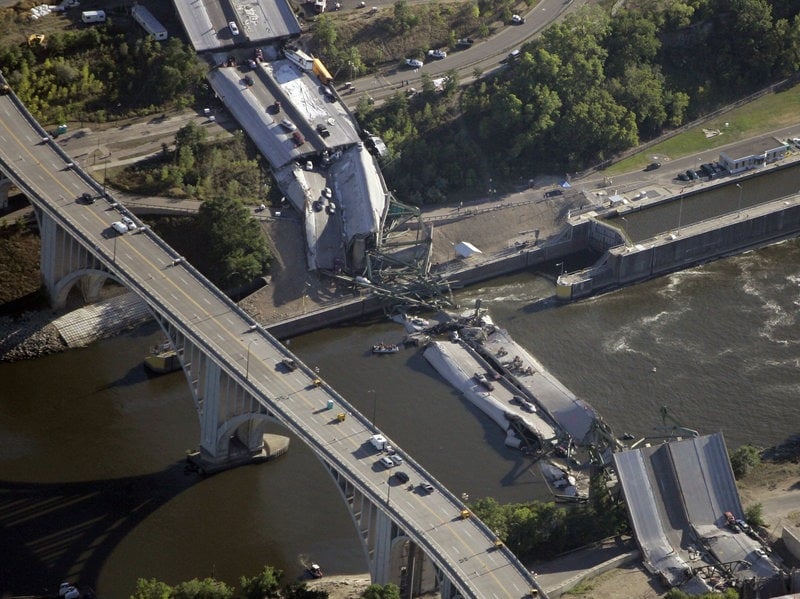
10 Reasons Why Bridges Collapse
22 August 2018Table of Contents
10 Reasons Why Bridges Collapse
You may not think about the bridges you cross on your way to work, but they’re far more than pretty structures that make your commute manageable. Bridges are crucial transportation links that carry road and rail traffic across rivers, gorges or other roads. When a bridge collapses or closes for repairs, it can cause massive traffic problems or strand people altogether, if they live on an island.
Some of the most massive and expensive engineering projects in history have involved building bridges. Although the general physics of bridge-building have been established for thousands of years, every bridge presents complicated factors that must be taken into consideration, such as the geology of the surrounding area, the amount of traffic, weatherand construction materials. Sometimes these factors are miscalculated, or something occurs that the bridge designers didn’t expect. The result can be tragic.
As we go through this list of 10 reasons why bridges collapse, keep in mind that most bridge collapses are the result of multiple factors. For example, a flood that damages bridge piers might not have caused a collapse — except for a design flaw and poor maintenance. Remove one of those factors and the bridge may have remained upright. On the other hand, sometimes a train smashes into a bridge and it just falls down. We’ll consider the possibilities, starting on the next page.
10. Earthquake
Earthquakes cause damage to all structures, including bridges. Major earthquakes can bring about the collapse of dozens of buildings, but collapsed bridges are often the most visible signs of the havoc an earthquake can wreak. Amidst the rubble and devastation, the sight of a damaged bridge from TV news helicopters stands out and becomes the iconic image of that particular disaster.
Such is the case with the Loma Prieta earthquake that struck the California coastal cities of Oakland and San Francisco in October 1989. The earthquake — named for a nearby mountain — caused 63 deaths, and the majority of them occurred in two bridge collapses: One person died as a section of the San Francisco-Oakland Bay Bridge gave way, and 42 others perished when a large portion of the Cypress Street Viaduct carrying Interstate 880 collapsed [source: USGS].

Fortunately, earthquake-triggered bridge collapses are relatively rare. In addition, builders can construct bridges in earthquake-prone areas to withstand tremors — or at least minimize the loss of life when one occurs.
9. Fire
Fire might be the rarest cause of bridge collapses, but fire has brought a few bridges down in the past. In fact, it used to happen much more often, when bridges were made out of wood. Train bridges were especially susceptible to fire, because the steel wheels of the train on the steel rails of the track frequently sent sparks shooting onto the bridge. If it was very dry or the wind fanned the sparks, the bridge could catch fire and burn completely down [source: Letchworth].
Bridge fires aren’t a thing of the distant past, however. Several modern bridges have also collapsed or been severely damaged due to fire. The cause is typically the crash of a tanker truck carrying a large amount of a highly flammable substance like gasoline. The crash triggers an explosion and a blaze so intense it melts the steel used to build the bridge. Eventually, the softened steel can no longer hold up the structure, and the bridge falls.

This is exactly what happened in 2009 when a tanker truck on I-75 near Detroit suddenly burst into flames directly under a bridge. The resulting inferno destroyed the bridge completely and forced the closing of I-75. Amazingly, no one was killed [source: Guthrie].
8.Train Crash
This type of bridge collapse is extraordinarily rare, but one of the worst rail disasters in history, the Eschede train disaster, was a bridge collapse caused by train impact. In 1998, a high-speed train traveling through Germany suffered a mechanical malfunction of one of the wheels. The broken wheel struck a switch and shifted it, throwing subsequent cars onto a different track. Moving at roughly 124 miles (200 kilometers) per hour, the cars derailed and slammed into the piers of a road bridge that passed over the railroad tracks at that point. The massive impact brought the bridge down directly onto the passenger cars of the train, crushing them. As a result, 101 people died in the accident [source: Oestern]. Eighty-three people lost their lives in a similar tragedy near Sydney, Australia in 1977 [source: ABC News].
Even rarer than trains crashing into bridges are airplane crashes that destroy bridges. The 1982 crash of Air Florida Flight 90 hit the 14th Street Bridge over Interstate 395 near Washington National Airport, killing several people in their cars. The bridge did not completely collapse, but did require extensive repairs [source: Wilber].
7. Boat Impact
Many bridges cross rivers and other bodies of water. Boats passing under a bridge are usually moving pretty slow (compared to trains), but boats have incredible mass. This means that even a barge, which typically creeps along at very slow speeds, can impart tremendous force if it collides with bridge pilings or piers. That force is sufficient to knock down the bridge in some cases.
An example of this type of incident is the collapse of the Judge William Seeber Bridge in New Orleans in 1993. The bridge carried road trafficover a canal, and a barge passing under the bridge struck a pier supporting the bridge and severed it. Nearly 150 feet (46 meters) of bridge collapsed as a result. One motorist driving on the bridge at the time died in the accident [source: NTSB]. More than a dozen major bridge collapses have been caused by boat collisions in the last 100 years [source: Wardhana].

6.Flood
Floods cause bridge collapses in a few different ways. Severe floods can cause rivers and creeks to overflow, picking up debris like trees, cars and parts of houses. When the river passes under a bridge, the high water level smashes the debris into the bridge. If the impact doesn’t destroy the bridge immediately, the weight of the piled up combined with the force of the flowing water pushing on it can bring the bridge down. This is what happened to the Conemaugh Viaduct in 1889, when the South Fork Dam in Pennsylvania collapsed, unleashing a massive torrent of water down the Little Conemaugh River [source: NPS].
Flooding can collapse bridges in a far more insidious way — by gradually wearing away the earth around and underneath the bridge piers. This process is known to bridge engineers as scour, and occurs whenever bridge foundations are placed underwater. The natural flow of the water can produce scour over many years, but bridges are built to withstand that type of erosion. Engineering techniques such as laying riprap, or layers of heavy rocks, can prevent scour. However, floods dramatically increase the force and volume of water affecting the bridge, and the damage to sediments can cause a bridge to collapse immediately or even days or months later. A study by the American Society of Civil Engineers determined that 53 percent of all bridge collapses are caused by flood and scour [source: Wardhana].
he Schoharie Creek Bridge is an example of a collapse caused by flood and scour. The bridge carried the New York State Thruway over the creek. In 1987, spring flooding caused high water levels. This washed sediment out from under one of the bridge piers, causing it to fall into a hole nearly 10 feet (3 meters) deep. Ten people died in the resulting bridge collapse [source: Storey & Delatte].
5. Construction Accidents

The Quebec Bridge collapsed twice during construction before finally being built.
A surprising number of bridges collapse as they’re being built. You might think these types of collapses aren’t as serious because no one was driving on the bridge at the time of the collapse. Unfortunately, some of the deadliest bridge collapses in history have occurred during the bridge’s construction. While a functional bridge may only have a few vehicles on it when it collapses, it takes hundreds of workers to build a bridge — all of whom may be in dangerous positions in case of collapse.
The 1907 collapse of the Quebec Bridge crossing the St. Lawrence River at Quebec City shows how engineering miscalculations can lead to disaster. The bridge was only partially constructed, but parts were already bending and breaking from the weight of the bridge itself. Engineers were concerned, but unable to take action swiftly enough. When it collapsed, 74 workers were killed [source: Structurae]. Amazingly, when the bridge was being rebuilt in 1916, it collapsed again, killing 13 more workers. It was finally completed in 1917 and remains in use today.
4. Manufacturing Defect
Some bridge collapses are mysteries when they first happen. It isn’t until a detailed investigation is completed that the true cause is revealed. Combing over the wreckage, engineers and accident investigators piece together the bridge’s history, looking at inspection reports and witness accounts of the collapse. At times, the simple failure of a small piece of the bridge caused the entire collapse. Sometimes low-grade or faulty materials were used, rendering the entire bridge too weak to withstand the rigors of time.
The 1967 collapse of the Silver Bridge over the Ohio River at Point Pleasant, W. Va. has become infamous for its connections to Mothman, a strange creature supposedly sighted near Point Pleasant in the months prior to the collapse (The 2002 Richard Gere film “The Mothman Prophecies,” chronicled the story). In truth, the collapse was due to a manufacturing defect in one of the steel eyebars that held the bridge up. Years of corrosion worsened the defect until it eventually failed, resulting in the deaths of 46 people [source: LeRose].
The 1994 collapse of the Seongsu Bridge in Korea was due to poor quality steel in some parts of the bridge and improper welding techniques in the bridge’s construction. 32 people were killed in the collapse [source: Korea National Emergency Management Agency]. The De la Concorde overpass in Laval, Quebec, Canada collapsed in 2006, killing five. The investigation revealed that some aspects of the bridge’s construction were done incorrectly and not according to the design, and that inferior quality concrete became too weak to support the structure.
3. Design Defect

Sometimes, bridges collapse due to design flaws
There are bridges whose collapse was inevitable before the bridge was ever built. The fault lies not with the construction of the bridge, but the design itself. The bridge is doomed to failure from the moment it was laid out on a blueprint.
One of the worst accidents in U.S. history is the collapse of the walkways in the Kansas City Hyatt Regency hotel. The walkways connected various parts of the second, third and fourth floors, overlooking the hotel lobby below — they were essentially pedestrian bridges inside the hotel. On July 17, 1981, the fourth-floor walkway collapsed, crashing onto the second-floor walkway which was directly below it. Both walkways then fell onto the lobby. Both the lobby and walkways were crowded with people watching or participating in an evening dance contest. The collapse killed 114 people [source: Associated Press].
Why did it happen? A redesign of the original plan caused the walkways to be constructed in such a way that structural elements ended up supporting the weight of both the second and fourth floor walkways simultaneously, doubling the load on them. Investigation revealed that even the original design was far too weak to support significant loads — and the redesign made the problem much worse [source: Martin]. It was nearly inevitable that they would collapse at the worst possible moment.
The 2007 collapse of the I-35 Bridge over the Mississippi River in Minneapolis, Minn. was also due to a design flaw. Steel gusset plates which bound key parts of the bridge structure together weren’t large enough. Additional weight placed on the bridge by concrete resurfacing and construction equipment caused the plates to buckle, and the entire bridge collapsed, killing 13 [source: NTSB].
2. Poor Maintenance
Poor maintenance is a difficult problem to diagnose in the wake of a bridge collapse. Many bridge collapses could have been prevented with more stringent inspection and maintenance routines, and lots of collapses that occur for other reasons are exacerbated by poor maintenance. When a bridge is designed, the engineers assume a certain level of maintenance that is necessary for the bridge to live out its intended lifespan. Rusted parts must be replaced, drainage areas cleared, new coats of paint applied and reinforcements added if traffic levels have increased.
A bridge carrying the Connecticut Turnpike over the Mianus River collapsed in the middle of the night in June 1983. The collapse was due to the failure of steel pins that had corroded. Investigators ruled that the bridge’s design and construction weren’t at fault — the collapse was blamed on deferred maintenance that would have spotted and replaced the rusted pins [source: NYCRoads].
1. Odd Occurrences

Some bridge collapses just can’t be explained at all.
We’ve discussed many causes of bridge collapse, but there are collapses that weren’t caused by any of the usual factors — rather, they were caused by events that can only be described as unusual.
In 1958, Cuba held the second Cuban Grand Prix. Legendary racer Juan Fangio was actually kidnapped by socialist revolutionaries before the race, but that wasn’t the worst thing about the event. The course was lined not with guard rails or safety fences, but with spectators standing right at the edge of the track. During the race, driver Armando Garcia Cifuentes lost control of his Ferrari and plowed into the crowd, destroying a temporary pedestrian bridge in the process. Seven people were killed [source: Edmondson].
The Lacey V. Murrow Memorial Bridge in Seattle crosses Lake Washington. It’s a floating bridge, suspended on pontoons. In 1990, a bizarre series of construction errors filled the pontoons with water used in resurfacing the bridge along with rain and lake water from a storm. Over the course of several hours, the bridge sank to the bottom of the lake.
The Winkley Bridge was a pedestrian suspension bridge in Arkansas. It was known for swaying significantly under load. In 1989, a group crossing the bridge started intentionally swinging it. They caused the bridge to sway so fiercely that the support structures failed and the bridge collapsed, killing five [source: Bridgehunter].


